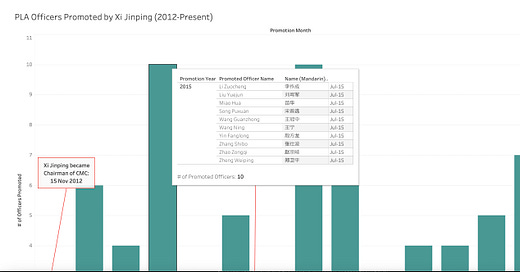PLA Anniversary, Intelligent evolution of unmanned reconnaissance, and The Dialectical Implications of the Ten Military Principles
Issue 39, 1 August 2022
Hello,
Today is the 95th anniversary of the People's Liberation Army (PLA). China's Ministry of National Defence threw a huge reception on this occasion. Several articles in PLA Daily and the speeches of Xi Jinping and other leaders have re-emphasized the importance of the PLA for the party and China. Although. general PLA updates are not the core theme of this newsletter, I have listed a few articles from PLA Daily which I thought are important.
Report on celebration of 95th anniversary of PLA (PLA Daily)
The Journey to victory (good explanation of the history of PLA and some key achievements of the PLA)
My colleague Manoj Kewalramani has analyzed some of the articles on PLA's anniversary published in People's Daily in his daily blog. Like PLA Daily, the entire front page of the People's Daily is dedicated to the coverage of anniversary special articles. You can read it here.
I have also added a suggested reading written by Edmund J. Burke, Kristen Gunness, Cortez A. Cooper III, and Mark Cozad from RAND Corporation on PLA's Operational Concepts. I highly recommend this reading for those who are interested in PLA. The link to the reading is in the Additional Reading section.
In case you missed it
We have launched a project Tracking PLA Members in the CPC Central Committee. This project documents the current distribution of PLA officers in the 19th Central Committee (19th CC). It seeks to analyze the changes that are likely in terms of the PLA’s representation in the 20th Central Committee. This is a dynamic project, which will be developed in parts over the course of the year leading up to the 20th Party Congress. In the first part, we have plotted the distribution of PLA members in the 19th CC. Further analyses about potential retirements and promotions will follow in subsequent parts.
You can access interactive graphics of the project here:
I. Military and Warfare
A. Intelligent evolution of unmanned reconnaissance
Zhang Dongrun and Zhang Wenhong (affiliation unknown) have outlined the evolution of unmanned reconnaissance in four points:
Dimensional change (维域之变 Wéi yù zhī biàn)
Changes in Energy Efficiency (能效之变 Néngxiào zhī biàn)
System change (体系之变 Tǐxì zhī biàn)
Change of advantage (优势之变 Yōushì zhī biàn)
Dimensional Change
Authors write that the spatial scope of intelligent reconnaissance has changed from the traditional "single-dimensional domain" and "multi-dimensional domain" to the "full-dimensional domain." Traditional reconnaissance operations collect intelligence data by assigning specific reconnaissance missions to reconnaissance units. However, With the application of intelligent technology, reconnaissance operations have begun to undergo revolutionary changes. Various types of unmanned reconnaissance vehicles can comprehensively carry out reconnaissance and surveillance in multi-dimensional space in multi-dimensional fields such as land, sea, air, sky, electricity, and network.
Changes in Energy Efficiency
Authors highlight that intelligent unmanned reconnaissance can better adapt to the uncertainty of the battlefield environment and reduce decision-making risks. Intelligent unmanned reconnaissance can collect intelligence information independently, compare and analyze it with multi-source data information, and then gathers data through each tactical node for further comprehensive analysis and processing. This data can then be unified through the intelligence information through the combat cloud. For the complex battlefield environment, the reconnaissance platform can independently analyze and decide according to the combat mission and combat environment. The platform can optimize select reconnaissance timing, routes, preset situation handling, special situation handling, and other functions that can effectively reduce the risk of reconnaissance operations and achieve safe, efficient, stable, and continuous intelligence acquisition.
System Change
The application of intelligent technology makes the system capability of unmanned reconnaissance stronger. The intelligence of reconnaissance uses the "machine language conversation" between reconnaissance equipment so that the reconnaissance operation changes from the "man-machine-human" intelligence demand model to the "machine-machine" intelligence support model. This promotes the development of unmanned reconnaissance from the traditional "single-player" single-soldier reconnaissance to the "cluster" and "cloud group" and other system reconnaissance.
Change of Advantage
The application of intelligent technology makes unmanned reconnaissance form a generation difference advantage. With the development of offensive network technology, artificial intelligence, multi-sensor fusion 5G technology, Internet of Things, cloud computing, and miniaturization technology, the advantages of the combat system formed by relying on precision guidance and information networks are gradually iterating, with intelligent systems as the core. These intelligent operations can offer an advantage during combat by helping to attack the enemy first.
B. The Dialectical Implications of the Ten Military Principles
In this article Xu Sanfei and Fu Wanjuan analyze the military principles in the era of intelligent warfare. The authors begin by writing, "when intelligent warfare has gradually become a new form of warfare, this article focuses on ten military principles, summarizing and sorting out the dialectical implications of nine aspects."
Strategic defiance and tactical emphasis
Careful preparation and the careful first battle
Destroy enemies and capture places
Take care of the overall situation and grasp the key points
Hit the weak first and the strong later
Concentrating and Dispersing Forces
Weaponry and Fighting Spirit
“You hit yours and I hit mine” (guidance methods for defeating the enemy with superior equipment using inferior equipment)
Sustained combat and recuperation
The article is long and mostly theoretical. Despite the promising title, the actual article does not shed any light on how these principles are really changed or different in the case of intelligent warfare. There is some mention of high-tech warfare here and there. Do read it in case you are interested in military theory.
Additional Reading
People's Liberation Army Operational Concepts (RAND Corporation)
War games to boost the transformation and upgrading of military training
Megha Pardhi is a Research Analyst at The Takshashila Institution. She tweets at @pardhimegha21.




